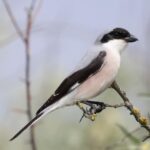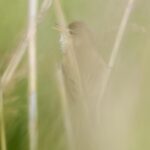Day 2 of a two day Private Tour today in North Norfolk. Having done so well out on the marshes and coast yesterday, particularly with waders and wildfowl, we decided to do something different today and try to find some woodland and farmland birds. The weather was not entirely helpful – it was rather cool and windy and the expected rain arrived earlier than forecast. Although it was just light drizzle it continued through to the middle of the afternoon. Still, it didn’t stop us getting out.
Our first destination for the morning was Holkham Park. As we got out of the car, we could hear a tit flock above us in the holm oaks and a Nuthatch was piping from one of the trees. It played rather hard to get for a while, hiding in the dense branches up in the tops. As well as the tits, we managed to see a couple of Goldcrests before the Nuthatch finally came out onto the edge of one of the trees.
Through the gates, we stopped to look at the feeders by one of the houses. There were several Great Tits coming and going and, after a short while, they were joined by another Nuthatch on the peanuts. We could see movement in the yew tree nearby and a Song Thrush flew out. A second Song Thrush was still feeding on the berries in the back of the tree, but hard to see in the dense foliage, as were a couple of Blackbirds.
As we continued on down towards the lake, we could hear Jays calling and one flew across between the trees as we arrived at the open area by the monument. A Treecreeper was calling from somewhere deep in the trees.
When we got to the lake, we could see a raft of ducks and grebes out on the open water in front of the hall, so we walked up that way first. There were several families of Great Crested Grebes on the lake, the adults still with their summer crests accompanied by stripy-headed juveniles, and we had a good look at them through the scope. Most of the ducks were Shoveler, with smaller numbers of Teal, Mallard and Gadwall, but just one Tufted Duck.
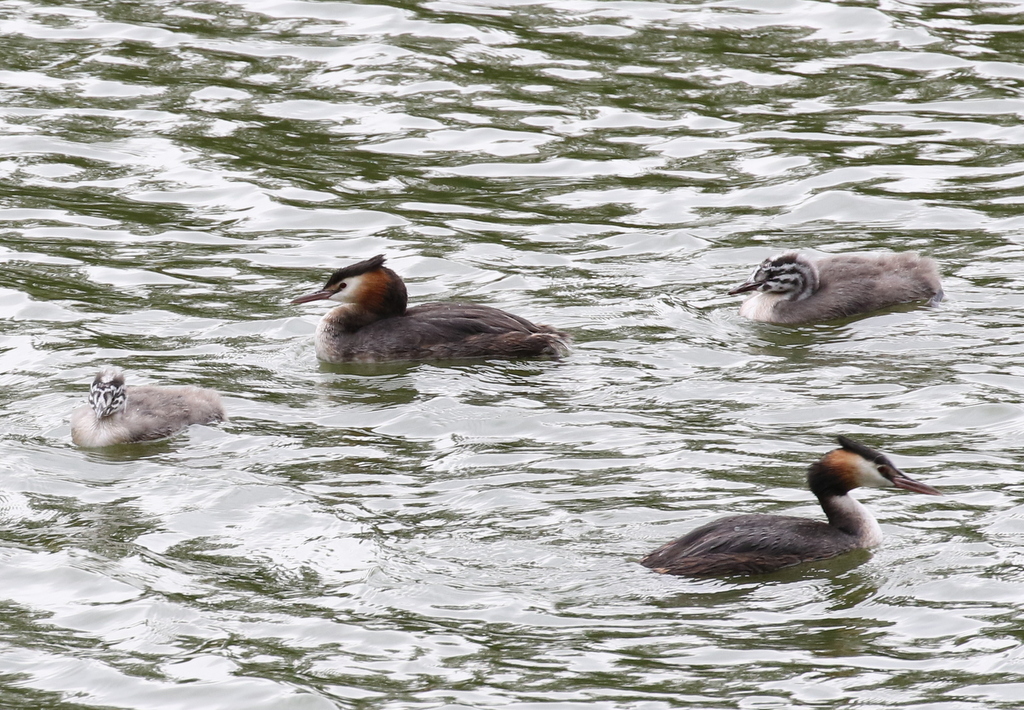
There were three Fallow Deer bucks out in the long grass across the lake, and when we walked down a little further towards the hall, we could see the bulk of the herd over towards the entrance road, sitting down on the shorter grass. A flock of Egyptian Geese were feeding on the outfield of the cricket pitch in front of the hall.
Heading back the other way, up towards the north end of the lake, there were a couple more families of Great Crested Grebes – they seem to have done well here this year. As we got into the trees again, a smart Fallow Deer buck was feeding close to the path and let us approach quite closely before it finally ran off.
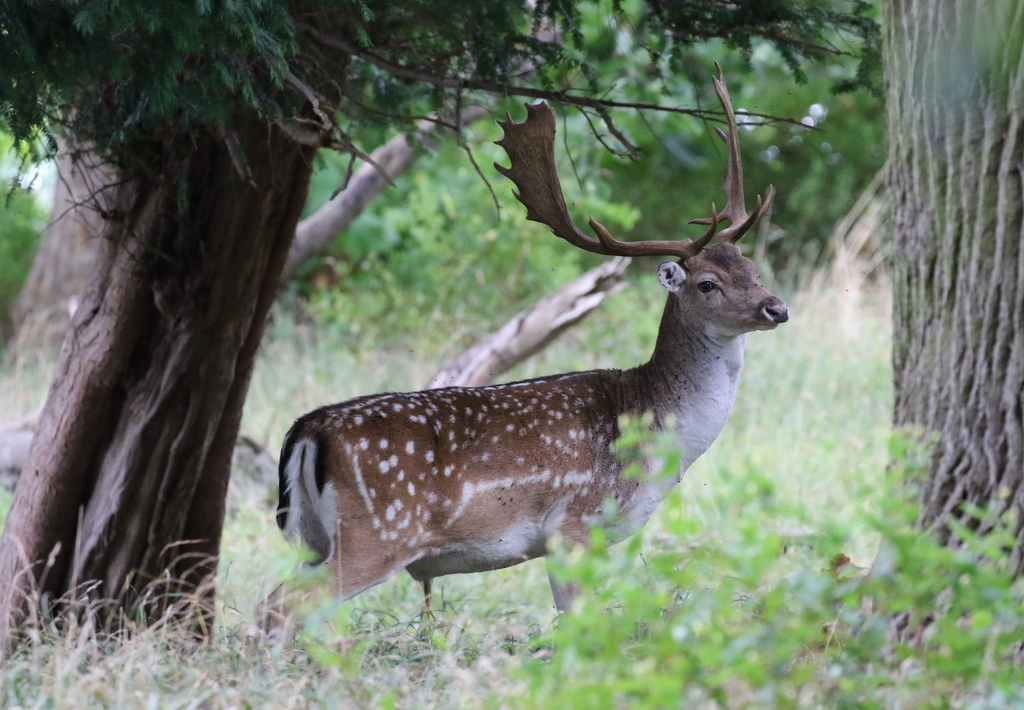
We could hear Long-tailed Tits calling in the trees ahead of us and we walked up to find a mixed tit flock on the edge of the lake. As well as the other regular tits, we had nice views of a pair of Coal Tits in a pine tree – a new bird for the list. A Treecreeper was calling from somewhere deep in the trees behind us, and when we turned to look for it we saw a Great Spotted Woodpecker fly out and land in a tree above our heads. By the time we turned our attention back to the Treecreeper, it had gone quiet.
A small falcon appeared from over the trees at the back and flew towards us over the lake. As it banked, we could see it had thin, scythe-shaped wings – a Hobby! Unfortunately it didn’t hang around and quickly disappeared over the treetops on our side of the water. Still, it was a good bird to see.
From the north end of the lake, we headed back through the trees. It was pretty quiet – apart from a Brown Hare which ran across the path – until we got back to the monument. We could hear a tit flock again and a couple of Treecreepers were calling from somewhere further in. We stood on the track and waited to see if they would come our way, but they seemed to be moving away from us. At that point it started to drizzle with rain. As we hadn’t been expecting it to arrive so early, and were not all equipped with our waterproofs, we made a hasty retreat back to the car.
We were planning to make our way east today, but rather than follow the coast road, we headed inland to look for some farmland birds on the way. Our first search for Grey Partridge at a good site for them drew a blank – a Kestrel on a post and a Common Buzzard in a field were the best birds here.
As we cut across behind the Park, we stopped to scan a field and a Green Sandpiper flew across and landed in a puddle in the gateway. It stayed just long enough for us to get a look at it, then flew off – a bit of a surprise find out here!
A little further on, we found a mixed flock of Lapwing and Golden Plover in a field of young oilseed rape. As we had only seen Golden Plover in flight yesterday, we got out to have a closer look in the scope. There were several smaller birds in the field too – a flock of Linnets and a smaller group of Meadow Pipits, another new bird for the list.
Continuing on along the road, a buff and white shape flew up from the verge ahead of us – a Barn Owl! We can often see Barn Owls out hunting in the daytime in the winter when they are hungry, but not so often at this time of year so this was another unexpected bonus. We followed slowly behind as it made its way along the verge ahead of us. It appeared to be carrying some prey, which it presumably had caught before we surprised it. It disappeared behind the hedge and appeared to land, so we stopped and walked back to a gap where we could see into the field. Unfortunately there was no further sign of it.
The field did provide us with a couple more new birds though. We could see a large covey of Red-legged Partridges out in the stubble but four more partridges over the far side of the field perched on a straw bale next to a game cover strip looked much duller. Through the scope, we could see they were Grey Partridges, just what we had been looking for! Then a Skylark came up from the stubble in front of us, flew back across the field, and dropped back in to the vegetation.
It was still cool and damp, although the drizzle had eased off a bit. Not great weather for owls, but we decided to push our luck and see if we could find a Little Owl next. We headed over to a complex of farm buildings which is a regular site for them. We parked up in a layby, and as we got out we noticed another covey of Grey Partridges right next to the road. A much better view than the ones we had just seen.
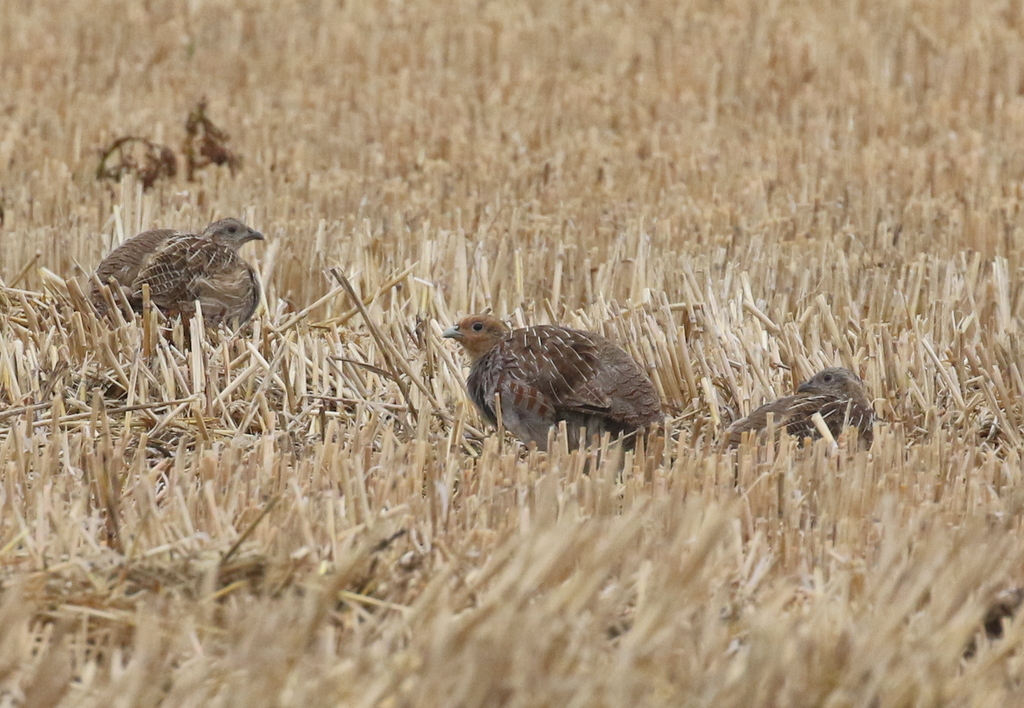
A flock of Mistle Thrushes took off from the trees by the layby and we could hear Bullfinches calling from deep in the vegetation. As we scanned the barns, we could see a small round shape on the edge of one of them, tucked in out of the wind and under the edge of the roof. It was a bit distant, but through the scope, we could see that it was a Little Owl. It was hunched up at first, but then seemed to rouse itself, preen and disappeared back into the barn behind it.
From there, we dropped back down to the coast and headed along to Cley. The wind seemed to have eased and the drizzle was only light now, although it was still a bit misty. We decided to have a look at the East Bank before lunch. As we got out of the car, we could hear Bearded Tits calling, but by the time we had got up onto the bank, they had gone quiet again.
There were several Curlew and lots of Greylags out on the grazing marshes, but we couldn’t see many waders out on Pope’s Pool today – just one or two Avocets. A selection of ducks – Teal, Shoveler, Wigeon and Mallard – were on the Serpentine, as well as several more Avocets feeding.
The hide overlooking Arnold’s Marsh provided some welcome shelter from the elements. We could see a few Sandwich Terns over towards the back and had a look at them through the scope. There were plenty of waders out on here, but not much variety – lots of Black-tailed Godwits and Redshanks and a few Curlew. A couple of Dunlin flew in, circled over the water, and carried on towards the reserve.

Continuing on to the sea, we could see a few more Sandwich Terns fishing offshore and a single Gannet flew past out in the distance towards the wind farm. It wasn’t a day to be lingering out on the beach so, with no sign of many birds moving, we headed back.
On our way, we heard another Bearded Tit calling, but they were keeping well tucked down out of the weather. When we were almost back to the car, we turned to see a female Marsh Harrier flying in over the grazing marsh and across the bank, before dropping down into the reedbed.
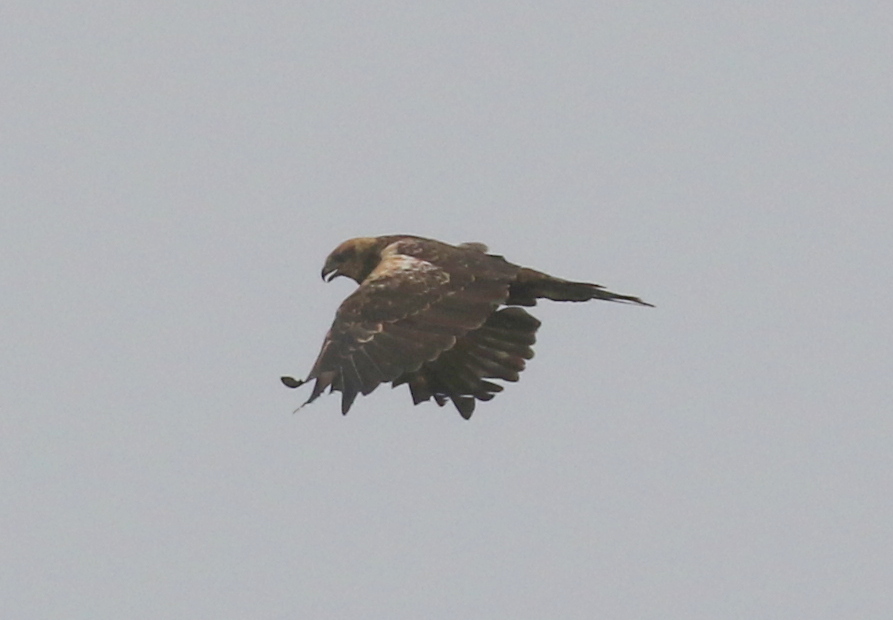
From the bottom of the East Bank, we had a quick look over at Snipe’s Marsh. We could see a small wader out in the mud amongst the cut reeds and a look through the scope confirmed it was a Green Sandpiper. A careful scan revealed a second Green Sandpiper feeding along the edge of the taller reeds at the back and, appropriately enough given the name of the location, four Common Snipe.
We would normally use the picnic tables at the Visitor Centre for lunch but given the weather we drove round to the beach car park and made use of the shelter there instead. We kept looking out to sea from time to time while we ate, but it was very murky and there was still no sign of any activity. After lunch we headed round to the Visitor Centre for a hot drink.
Our attention originally had been to spend some time at Cley today, but the sightings board revealed there was nothing here today that we had not seen already at Titchwell yesterday, so we decided to try somewhere else. It was not great weather for looking for small birds, but we thought we would try our luck at Kelling.
The track down to the Water Meadow was fairly quiet. A Blackcap was calling in the bushes and we heard a few Chaffinches too. The only small birds in the brambles around the pool were Linnets and a couple of Reed Buntings were in the reeds. There were plenty of gulls here again, bathing and loafing on the bank – mostly Black-headed, several Herring and two or three Lesser Black-backed Gulls as well.
The track to the beach produced a single juvenile Stonechat, accompanied by a Common Whitethroat, but there was no sign of any migrants here. We started to make our way up the hillside behind the beach but it was rather cold and damp, so we turned decided to cut our losses and try somewhere else.
As we drove back west along the coast, the drizzle stopped, the mist lifted and the sky appeared to be clearing from the north. As we made our way down along the footpath beside the river towards Stiffkey Fen, we could hear Long-tailed Tits calling in the copse and a large mixed tit flock started to emerge from the trees ahead of us. Several birds landed in a large hawthorn on the edge of the meadow – we could see three different Blackcaps, a Chaffinch, and a selection of tits.

The flock continued to move quickly through the bushes ahead of us. There were lots of birds and small groups would pause from time to time to feed in one of the trees. We saw several Chiffchaffs and lost count of the number of Blackcaps, but unfortunately a Lesser Whitethroat just hopped up briefly and disappeared before everyone could get onto it.
When the flock moved into the thicker trees, we continued on along the path. From a gap in the sallows it is possible to see over the brambles to the Fen beyond. There were lots of Greylags on the islands and in with them were three escaped Bar-headed Geese and a Fulvous Whistling Duck. Smart birds, but unfortunately, they don’t count! We could see two Spoonbills asleep, and several Little Egrets against the reeds beyond.
There is a better view of the whole Fen from up on the seawall. From here, we could see more of the ducks – as wall as plenty of Teal, Shoveler, Mallard and Wigeon, we found three Pintail in with them.
There were lots of waders in amongst the wildfowl too, particularly good numbers of Ruff and fewer Black-tailed Godwits. Scanning the muddy edges, we found a Common Sandpiper and three Green Sandpipers, at one point with the two species side by side for comparison. There were four Common Snipe on the mud on the edge of the reeds too.
We had a better view of the Spoonbills from up here too. One of them woke up and started to preen, flashing its long spoon-shaped bill, black with a yellow tip. Then a third Spoonbill flew in from the harbour behind us. As it came in over the back, we could see it had a much shorter bill – a juvenile, a ‘Teaspoonbill‘ whose bill is not yet fully grown.
The juvenile Spoonbill made a beeline for the adult which had just woken up. It walked up to it, bobbing its head up and down and flapping its wings, begging to be fed. The adult Spoonbill tried to walk away, but the juvenile was having none of it, and the adult gave in remarkably quickly and fed the youngster – sometimes these begging pursuits can go on for ages!
The adult Spoonbill then took off and headed out towards the harbour – whether to replace the food it had just surrendered or to get away from its begging offspring was not clear. It flew towards us on the seawall and straight past, giving us a fantastic close fly past.
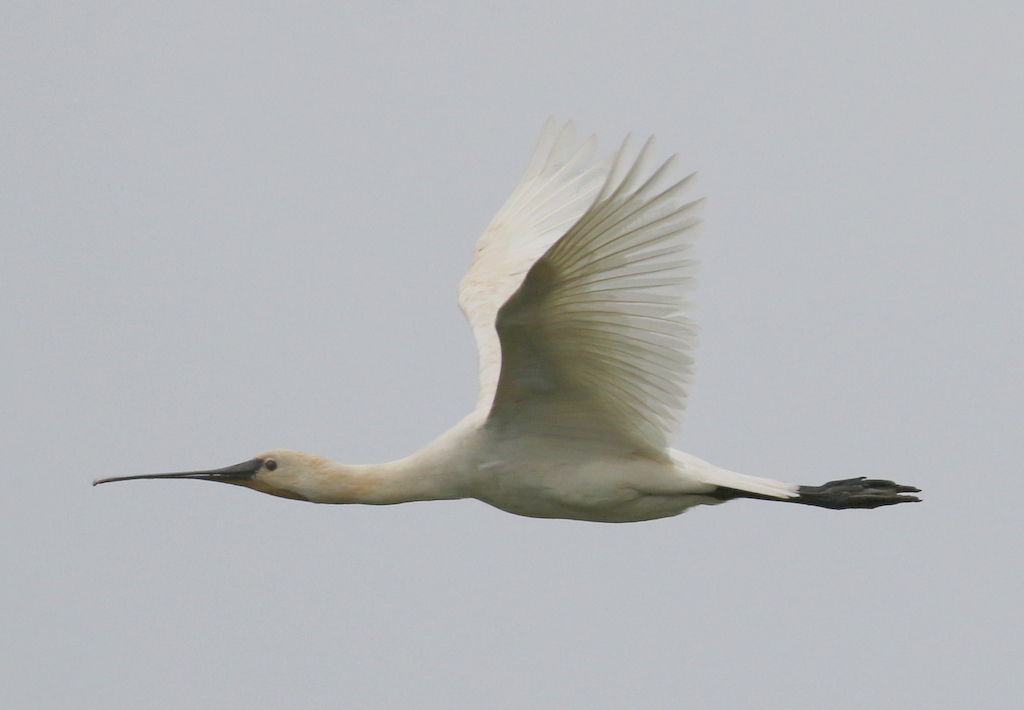
We turned to scan the harbour. The tide was out and there were lots of birds spread over the mud in the distance. We could see a huge group of loafing gulls, with another Spoonbill sleeping in with them. There were undoubtedly more waders out of view in the bottom of the pit, but we could see hundreds of Oystercatchers and a good number of Grey Plover including several still in their smart breeding plumage.
Over on the beach beyond the tip of Blakeney Point there were lots of seals hauled out on the sand. It won’t be long before the Grey Seals are pupping now.
Unfortunately it was time to start making our way back now. We were treated to another great view of the Long-tailed Tits, feeding on the blackberries by the path.

It had been a very enjoyable couple of days birding – and a very productive one too. A great introduction to the delights of the North Norfolk coast and its birds.
